Contents
Market Overview
Macro Review
Markets were positioned for a toppy NFP release. The U.S. employment report was shy of expectations, which came after a stronger ADP report on Thursday (978k vs 650k exp.), even if it is usually a poor predictor before the non-farm payrolls. The ADP data coupled with the highest-on-record ISM Services release of 64.0, initially pushed U.S. Treasuries wider this week. However, a recent JPM survey also highlighted that investors were largely short U.S. Treasuries, which exacerbated the move tighter into the end of the week. On top of this, Fed Vice Chair Clarida surprised participants by his hawkishness on tapering. The next surprise came with the Fed’s decision to cancel the SMCCF facility. This facility stands at $13.9bn, which is split $8.6bn between ETFs and $5.2bn in specific bonds. The largest ETF position is LQD in $2.3bn (27%), then VCSH in $1.5bn (18%) and VCIT in 1.4bn (16%). There are 1,204 bond positions with an average ticket size of 4.1m, where the largest positions are in AB Inbev, AT&T and Verizon. Given the shorter week with a number of EM and DM holidays, activity was generally subdued. In keeping with the word subdued, Chinese data releases continued to plateau, just as RMB appreciation measures were introduced (FX RRR 2ppts hike). Elsewhere, Turkish media appeared to be driving a wedge between the CBRT governor and Erdogan, which comes as the next MPC approaches with credibility in question. However, in the near-term Suriname is seeking to enforce a 70% haircut on creditors, which has already triggered a sell-off across the sovereign bonds outstanding.
EM Credit Update
EM Credit ended the week up 0.2% with EM Local up 0.6%. U.S. Treasuries were in a holding pattern until Thursday, before beginning to widen but not enough to dent the strong sentiment in EM. Zambia, Sri Lanka and Argentina outperformed while Suriname, Slovakia and Tunisia lagged.
The Week Ahead
Most focus will follow U.S. inflation after the NFP release, although the Bank of Canada and ECB meetings remain key fixtures for G10 tapering discussions. Russia could become the first EM Central Bank to successively hike rates on three consecutive occasions, as the market prices in a 25bp move next Friday. Meanwhile, Chile (0.50%), Kazakhstan (9.0%), Peru (0.25%) and Poland (0.1%) are expected to remain on hold. Elsewhere after the impressive run in ZAR, GDP for 1Q21 is expected to contract albeit at a slower pace of -2.4%, from -4.1% in 4Q20. Away from that we can expect the usual slew of inflation releases from Brazil, China, Colombia, Hungary, Romania and Taiwan, where the impact on food prices will be the key focus.
Highlights from emerging markets discussed below include: China incrementally calibrates policy while economic activity remains robust; uneventful initial U.S.-China trade talks; Turkish Lira (TRY) under renewed pressure as comments by President Erdogan on monetary policy amplify lingering geopolitical and domestic political concerns; Mexico mid-term election polls suggest little near-term policy change; economic activity data firms; and Global Emerging Markets Corporates in Focus: A brief look at discretionary payments.
Fixed Income
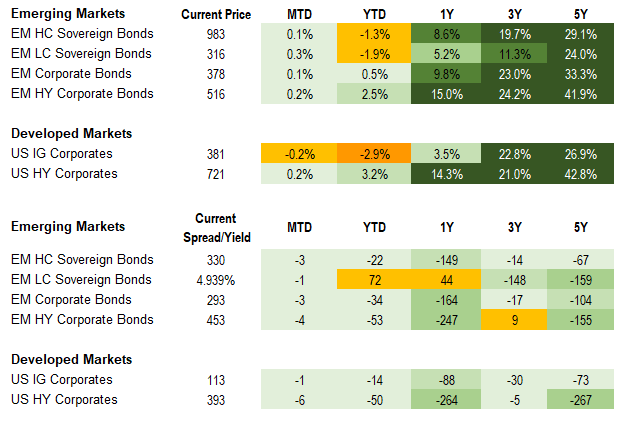
Equities
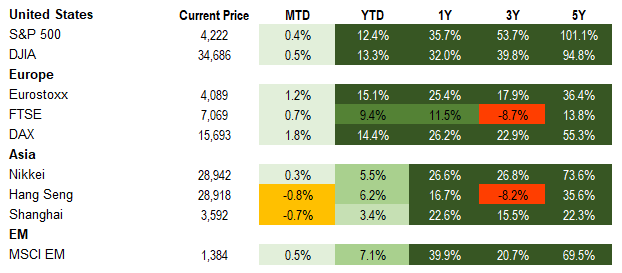
Commodities

Source for data tables: Bloomberg, JPMorgan, Gramercy. EM Fixed Income is represented by the following JPMorgan Indicies: EMBI Global, GBI-EM Global Diversified, CEMBI Broad Diversified and CEMBI Broad High Yield. DM Fixed Income is represented by the JPMorgan JULI Total Return Index and Domestic High Yield Index. Fixed Income, Equity and Commodity data is as of June 4, 2021 (Mid Afternoon).
Emerging Markets Weekly Highlights
China incrementally calibrates policy while economic activity remains robust; uneventful initial U.S.-China trade talks
Event: The PBOC hiked its RRR (reserve requirement ratio) on foreign currency deposits from 5% to 7% reducing dollar liquidity by an estimated $20bn, increased allowance for outbound investment by $10bn, and aimed to manage market expectations by talking down yuan appreciation. CNY strength subsided after last week’s rally. This follows recent measures and rhetoric in an aim to cool commodity price pressure. Meanwhile, May PMI composite data remained comfortably within expansionary territory at 53.8, despite slight moderation from 54.7 in April. Both manufacturing and non-manufacturing components were solid albeit with mild disappointment relative to expectations in services. Lastly, China’s Vice Premier Liu He held initial trade conversations with U.S. Trade Representative Katherine Tai and Treasury Secretary Janet Yellen.
Gramercy Commentary: The efforts to curb currency and commodity price appreciation are aligned with China’s gradual normalization of policy and returned focus to financial stability. The measures are likely an attempt to prevent and limit FX lending and debt build-up, ward off speculative behavior, and preserve export competitiveness. We expect the administration to continue to incrementally adjust policy as the cycle progresses with prospects for moderation in growth momentum albeit with activity sustained at a robust level. Balance of payment dynamics have been supportive with a still robust current account surplus though a pick-up in imports and services deficit as well as export market share evolution as the recovery progresses may erode the surplus more materially over the medium term. We do not anticipate any near term changes to U.S.-China trade policy given the broader challenges and nuances to the relationship but do not rule out selective tariff relief later in the year or 2022, particularly if global inflationary pressures linger.
Turkish Lira (TRY) under renewed pressure as comments by President Erdogan on monetary policy amplify lingering geopolitical and domestic political concerns
Event: The Lira reached new lows against the USD this week, as global investors’ uneasiness about a number of risk factors plaguing Turkish markets grew. Those factors include, among others, a criminal probe launched against Istanbul’s popular opposition mayor Ekrem Imamoglu, continuing video “revelations” about wrongdoings by the government from an exiled former mob boss, and noise around diplomatic tensions with the U.S. and Russia. To complicate matters further, President Erdogan made fresh comments about “lower interest rates” despite sticky elevated inflation.
Gramercy Commentary: In an environment of constant “headline risk” emanating from Turkey’s complex and volatile geopolitical and domestic political dynamics, market performance of Turkish assets, especially the currency, tends to be a function of “policy credibility” or lack thereof. In the case of Turkey, it is mainly driven by the ability and willingness of the Central Bank (CBRT) to maintain a sufficiently tight monetary policy stance to counterbalance numerous macro imbalances and compensate investors for the inevitable higher political/geopolitical risks compared to other major EMs. The current episode of TRY weakness illustrates how policy credibility has suffered a material erosion from a market perspective because of frequent political pressure on the Central Bank. Current CBRT Governor Sahap Kavcioglu and his team have been trying hard to reassure markets that pre-mature monetary policy easing is not on the table. However, their efforts have not been sufficient to arrest the TRY’s slide, given investor concerns that tightening of monetary policy to control sticky elevated inflation is highly unlikely amid President Erdogan’s repeated calls for “lower interest rates”. Additionally, a challenging outlook for tourism recovery and higher energy prices continue to pressure Turkey’s external accounts, and, by extension, FX reserves and the TRY. Furthermore, diplomatic disagreements with the U.S. remain significant and are unlikely to be resolved by the upcoming meeting between presidents Biden and Erdogan on June 14 at the sidelines of the NATO summit in Brussels. Against this backdrop, we expect a challenging market environment for Turkish assets to persist, especially on the local/FX side, and we remain highly selective and opportunistic in our investment strategies.
Mexico mid-term election polls suggest little near-term policy change; economic activity data firms
Event: Ahead of the June 6th mid-term elections, voter intention for the Lower Chamber reflects support for the ruling Morena-led coalition of around 50% compared to the opposition bloc of roughly 40%. Meanwhile, the IMEF Manufacturing Index picked up to 52.3 in May from 50.3 in April while Non-manufacturing held steady at 53.6. Markit Manufacturing PMI was relatively stable at 47.6. Banxico further revised its growth and inflation forecasts in upward its Quarterly Inflation Report to 5-7% and 3.8%, respectively.
Gramercy Commentary: We expect the ruling coalition to lose some support in the Lower Chamber with decent prospects to retain a simple majority. The initial market reaction may be muted as the outcome is likely mostly priced to marginally positive in the backdrop of a moderately more powerful opposition. Despite potentially more difficult negotiations and pushback from the opposition, President Andres Manuel Lopez Obrador’s popularity remains high and he will leverage this to continue to pursue his agenda and cement his legacy over the next three years. This will pose continued headwinds and risks to institutional quality, increasing downward rating pressure over the medium term. Near-term growth and fiscal risks have receded amid the robust cyclical recovery and comparatively conservative stance through 2020 but structural challenges will likely persist absent a change in policy. To the extent the government outperforms in the election, initial greater asset volatility may ensue albeit with a similar outlook for the medium term.
Global Emerging Markets Corporates in Focus: A brief look at discretionary payments
Event: In May, UniCredit announced that once again, coupons on its Convertible and Subordinated Hybrid Equity-Linked Securities (CASHES) would not be paid. This decision was made after the Group reported a loss for 2020.
Gramercy Commentary: The complex and somewhat unique nature of the CASHES means the read across to other instruments with discretionary payment language should be limited. Importantly, the Italian Group has not applied the same discretion to payments on its Additional Tier 1 instruments (AT1s). In emerging markets, payments on AT1s at banks we track have been maintained despite the significant challenges of the COVID-19 pandemic. Not only have banks maintained these payments but most have also exercised the call options on AT1s/hybrid capital securities at the first call dates. Others have redeemed such instruments at subsequent call dates. 2022 will be an important year in this regard, as the first call date on VTB’s USD2.25bn deeply subordinated security falls in December of that year. A skipped payment in emerging markets may have more significant effects on the issuer and its market than in developed markets. This, perhaps, has contributed to payments on deeply subordinated instruments being maintained. In addition, restrictions on dividend payments imposed in some jurisdictions have not been extended to hybrid capital securities. This has clearly helped support the market for these instruments. In recent weeks, some emerging market lenders have issued USD-denominated AT1s for the first time. This list of issuers includes banks based in Colombia, Oman, Panama and South Africa. The landscape is clearly becoming more diverse. The current expectation is that the approach to payments and calls will be less so.
Emerging Markets Technicals
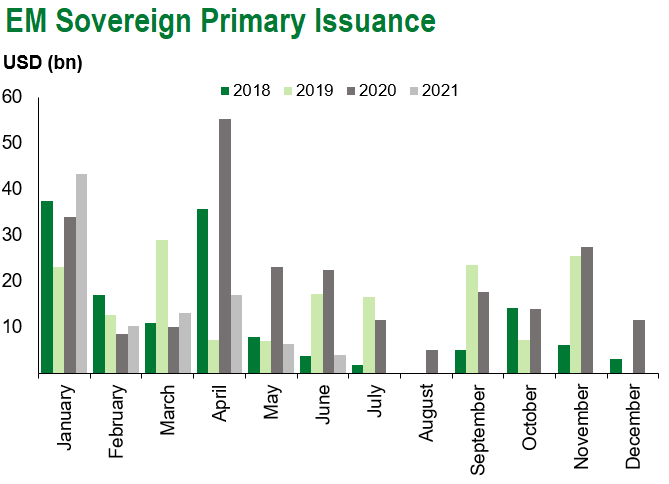
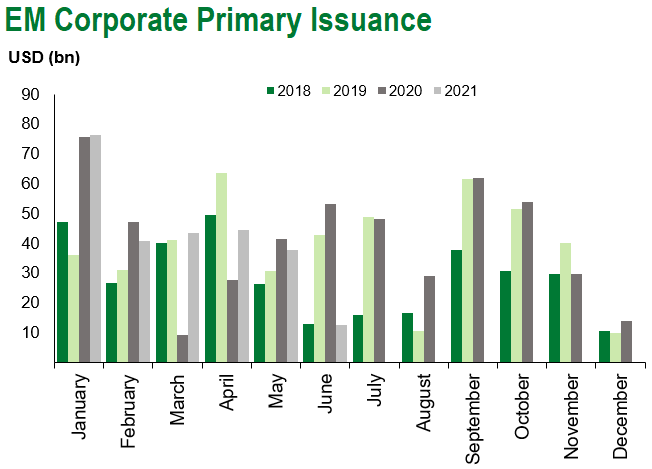
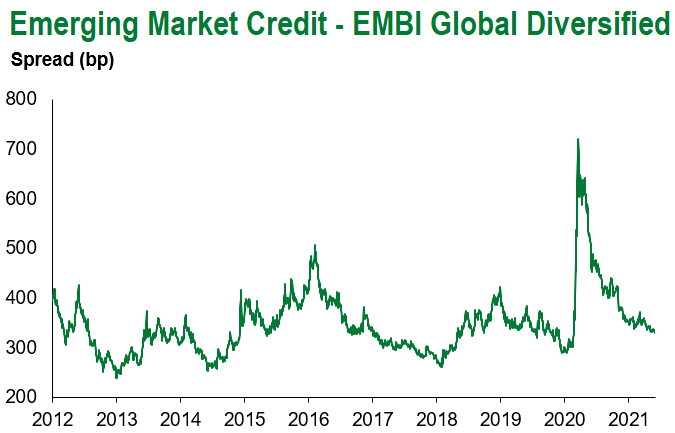
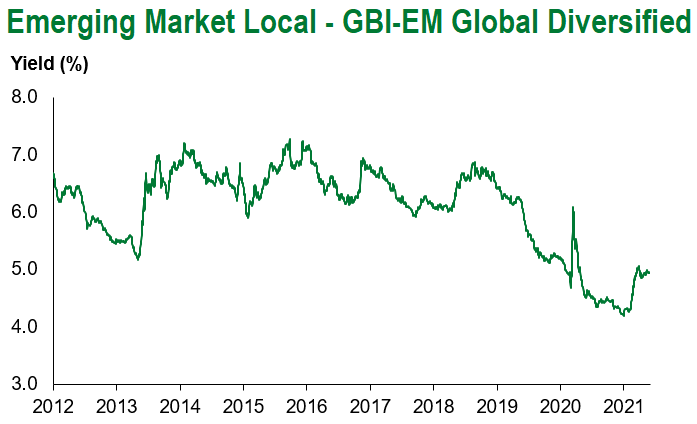
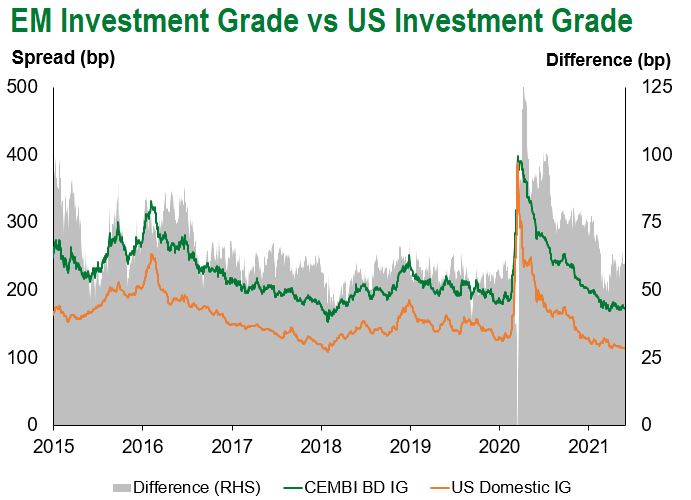
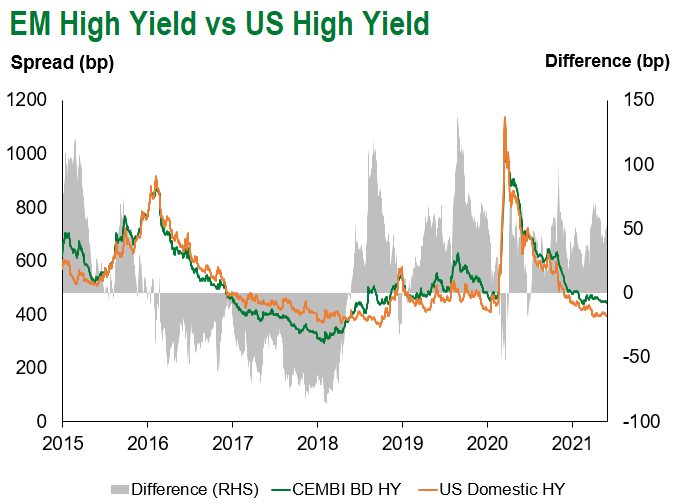
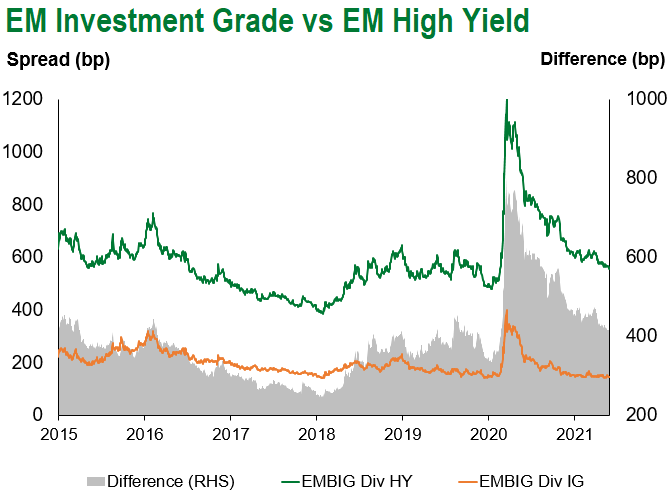
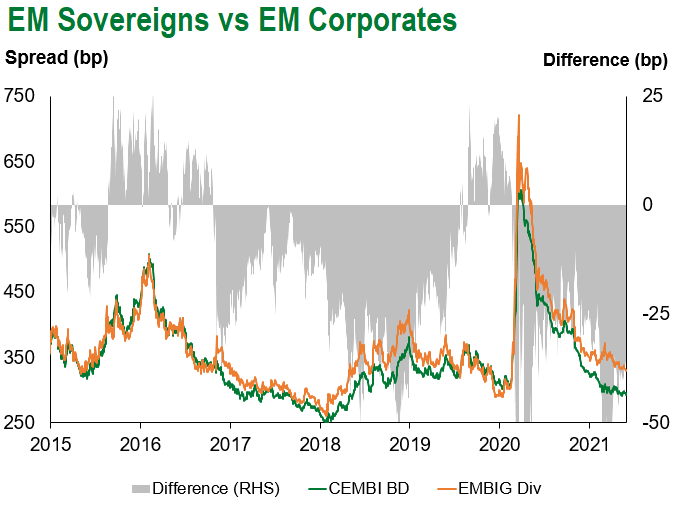
Emerging Markets Flows
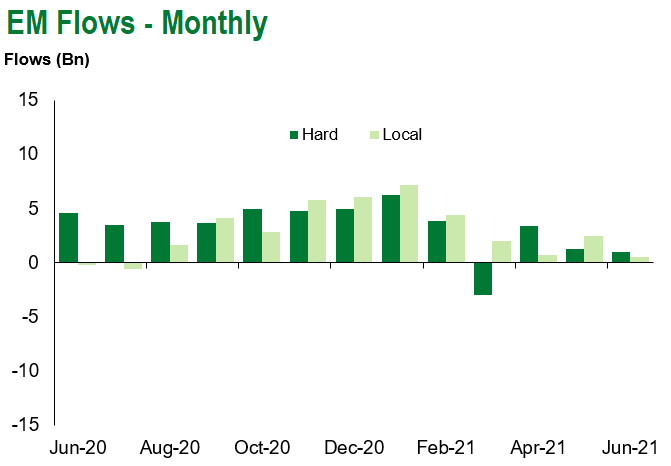
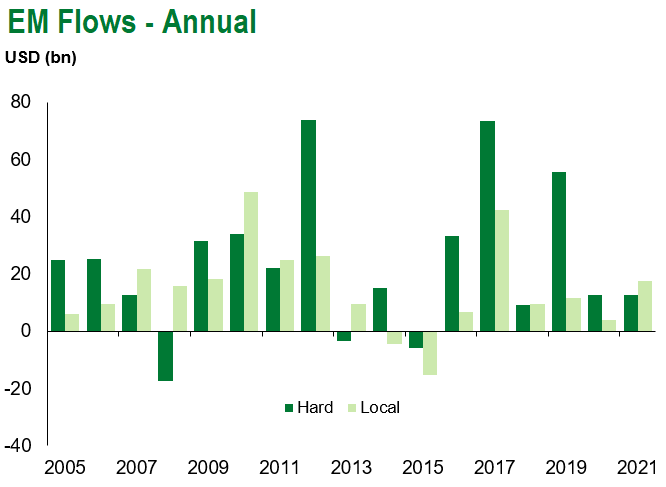
Source for graphs: Bloomberg, JPMorgan, Gramercy. As of June 4, 2021.
COVID Resources
Emerging Markets COVID-19 Case Summary
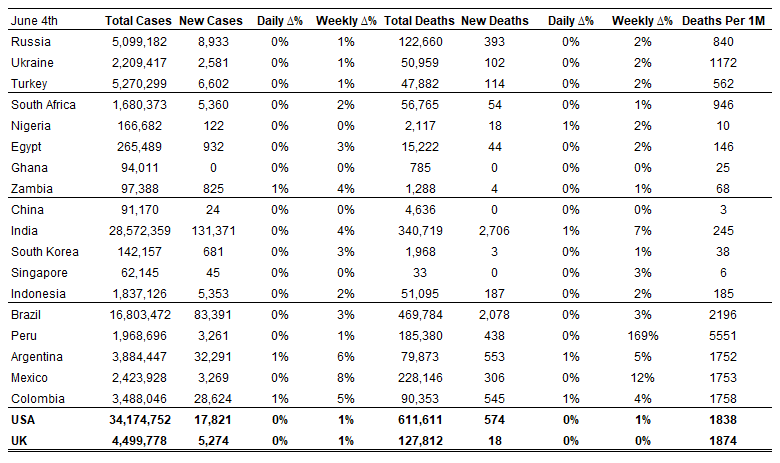
Source: Worldometer as of June 4, 2021.
Additional Crisis Resources:
Johns Hopkins COVID-19 Case Tracker
For questions, please contact:
Kathryn Exum, Senior Vice President, Sovereign Research Analyst, [email protected]
Petar Atanasov, Senior Vice President, Sovereign Research Analyst, [email protected]
Tolu Alamutu, CFA, Senior Vice President, Corporate Research Analyst, [email protected]
James Barry, Vice President, Corporate Research Analyst, [email protected]
This document is for informational purposes only. The information presented is not intended to be relied upon as a forecast, research or investment advice, and is not a recommendation, offer or solicitation to buy or sell any securities or to adopt any investment strategy. Gramercy may have current investment positions in the securities or sovereigns mentioned above. The information and opinions contained in this paper are as of the date of initial publication, derived from proprietary and nonproprietary sources deemed by Gramercy to be reliable, are not necessarily all-inclusive and are not guaranteed as to accuracy. This paper may contain “forward-looking” information that is not purely historical in nature. Such information may include, among other things, projections and forecasts. There is no guarantee that any forecasts made will come to pass. Reliance upon information in this paper is at the sole discretion of the reader. You should not rely on this presentation as the basis upon which to make an investment decision. Investment involves risk. There can be no assurance that investment objectives will be achieved. Investors must be prepared to bear the risk of a total loss of their investment. These risks are often heightened for investments in emerging/developing markets or smaller capital markets. International investing involves risks, including risks related to foreign currency, limited liquidity, less government regulation, and the possibility of substantial volatility due to adverse political, economic or other developments. The information provided herein is neither tax nor legal advice. Investors should speak to their tax professional for specific information regarding their tax situation.